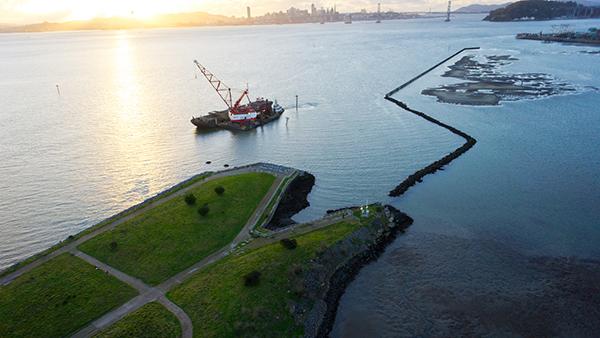Dredging
Dredging and depositing of dredged material
Dredging is the removal of sediment from the bottom of water environments. It is an essential practice in operations such as maintaining navigation channels, development of ports, remediation and flood management. Dredging including geological material from previously unexposed layers, is called capital dredging. Dredging done in order to maintain berths and navigation channels at advertised depth, is called maintenance dredging.
Much of the material removed during these necessary activities requires a deposit at sea. However, some part of the material dredged are used for beneficial purposes, such as construction or coastal protection, and some are also disposed at confined facilities on land.

Photo: Michael Layefsky/Flickr
Dredging and depositing of dredged materials is one of the environmental pressures on the seafloor and its inhabitants, with even a cumulative impact on benthic biotopes. Furthermore, as dredging releases suspended particles from the sediments into the water column, the water transparency is impaired. The sediments may also release nutrients and hazardous substances, such as heavy metals and organic contaminants, to the water column and affect marine life. The dredging activities also usually generate impulsive underwater noise, which is an additional harmful factor for marine organisms. Dredging and depositing of dredged materials is the most severe pressure in most of the northern areas of the Baltic Sea.
There is a general prohibition of dumping in the Baltic Sea according to the Helsinki Convention, except for dredged material; however, dumping of dredged material containing harmful substances is only permitted according to HELCOM Guidelines for Management of Dredged Material at Sea. The Guideline is part of the HELCOM recommendation 36/2, which was adopted in 2015. The Contracting Parties are obliged to regulate and also annually report the material that has been deposited in the Baltic Sea Area.
The HELCOM recommendation 36/2 and the guideline urges the data on dredging activities to be submitted to HELCOM Secretariat by 1 October of the year following the dredging activity. Reporting of the dredging sites, connected to these depositing activities, is not mandatory, but reported by several Contracting Parties. After the data has been reported, it is integrated to the HELCOM database of dredged material and verified by the national reporters.
Based on the reported data, an updated spatial data set on dredging and depositing activities is published annually in the HELCOM Map and Data Service. An assessment of the reported data, including graphs and maps on the amount and origin of deposited material and contaminants, is published annually as a Baltic Sea Environmental Fact Sheet. As agreed by HELCOM 41-2020, the HELCOM Secretariat annually reports to the London Convention and its 1996 Protocol on behalf of HELCOM Contracting Parties. The most recent data reported by the Contracting Parties can be explored in the visualisation below.
The HELCOM Expert Group on Dredging/depositing Operations at Sea (EG DreDS) is working to support the reporting and verification of data on dredging/depositing operations at sea. The group meets a few times annually and also works via correspondence, to discuss the reporting and other emerging topics, such as assessment of environmental pressure caused by dredging/depositing operations at sea and providing expert input to relevant actions in the updated BSAP.
